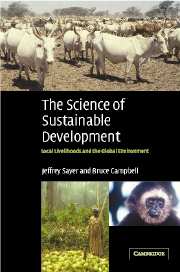Book contents
- Frontmatter
- Contents
- List of figures
- List of boxes
- List of tables
- Foreword
- Preface
- Acknowledgements
- Part I Integrating natural resource management
- Part II Realities on the ground
- 6 Institutions for managing natural resources in African savannas
- 7 Forest margins in Indonesian Borneo
- 8 Learning by doing on tropical American hillsides
- Part III The research–management continuum
- Bibliography
- Index
7 - Forest margins in Indonesian Borneo
Published online by Cambridge University Press: 18 May 2010
- Frontmatter
- Contents
- List of figures
- List of boxes
- List of tables
- Foreword
- Preface
- Acknowledgements
- Part I Integrating natural resource management
- Part II Realities on the ground
- 6 Institutions for managing natural resources in African savannas
- 7 Forest margins in Indonesian Borneo
- 8 Learning by doing on tropical American hillsides
- Part III The research–management continuum
- Bibliography
- Index
Summary
The vast rainforests of the island of Borneo have excited the imagination of scientists and traders for centuries. Outsiders saw them as a wild and inhospitable wilderness inhabited by headhunting tribes of Dayaks. They were the home of new and exotic animals and plants and a source of scarce and valuable products: birds' nests, gaharu, rhinoceros horn, etc. Until the latter half of the twentieth century, forests covered most of the island and small trading posts at the mouths of rivers were the main point of contact for the outside world with the sparse but significant populations of Dayaks who inhabited the hinterland. In the late 1960s, construction booms in Japan, Europe and North America and the availability of mobile chain saws and tracked vehicles led to the beginning of industrial-scale logging for international markets. This period also saw the strengthening of efforts by the Indonesian government to resettle people from the densely settled island of Java into the frontier areas of the outer islands of Indonesia.
The 1970s and 1980s saw major investments in opening up the remote forests of the Indonesian provinces of Kalimantan in Borneo. New roads were constructed for logging and to provide access to areas of planned agricultural settlement (transmigration). Central government institutions established footholds throughout the region. Significant commercial and public sector investments were made in the ‘development’ of the area.
- Type
- Chapter
- Information
- The Science of Sustainable DevelopmentLocal Livelihoods and the Global Environment, pp. 144 - 169Publisher: Cambridge University PressPrint publication year: 2003



